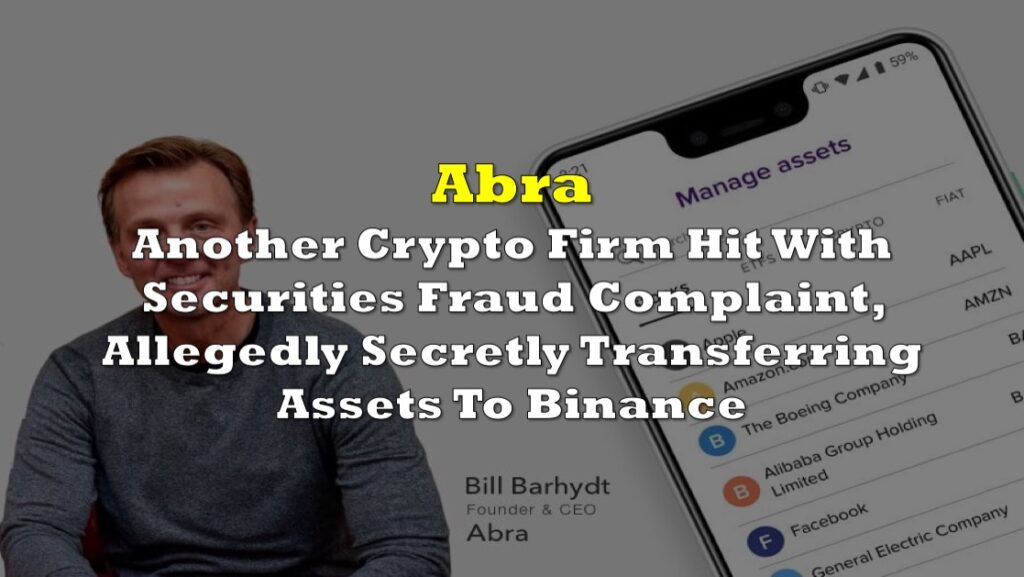Picture this. The biggest crypto exchange in the world, Binance, is now in the crosshairs of the US government. You know things are getting serious when various levels of government bureaucracy team up like an episode of the Avengers, but instead of battling Thanos, they’re taking aim at Binance. And with Binance’s connection to Tether, we might be seeing the beginning of the end for the entire crypto-universe. So buckle up, folks, because this could be your last chance to hop off the crypto rollercoaster before things get really ugly.
If you haven’t been keeping up with the news, Binance, the crypto giant, is facing some serious heat from US regulators. It’s like the government is trying to give Binance a not-so-warm bear hug, squeezing tighter and tighter until it pops like a balloon. We’re talking about lawsuits from the CFTC, an ongoing investigation from the SEC, and even the Justice Department getting involved. It’s like the crypto equivalent of a celebrity roast, except the jokes are subpoenas, and the laughter is the sound of investors panicking.
Binance, founded in 2017 by Changpeng Zhao or CZ, as he’s known in the cryptosphere, quickly became the go-to platform for trading all things digital and currency-related. It’s like the Amazon of crypto exchanges, but instead of selling you weird gadgets and knockoff electronics, it’s trading in digital currencies that might or might not have any real-world value.
Binance has become so important to the crypto community that it handled a whopping 92% of Bitcoin’s spot trading volume at the end of 2022. So, if Binance goes down, it’s like watching the Death Star explode – but with more financial consequences and fewer Ewoks celebrating.
The CFTC complaint against Binance is like a smorgasbord of alleged financial shenanigans, each more brazen than the last. In one corner, we have allegations of Binance giving high-frequency traders preferential treatment. In another, we find accusations of Binance’s “anti-money laundering” efforts being about as effective as a screen door on a submarine. And let’s not forget the claims of market manipulation, where it seems Binance took a page out of the Wolf of Wall Street playbook.
One particularly damning quote from the complaint alleges that CZ himself was fully aware of the regulatory dodgeball game he was playing. The filing states, “Zhao has expressed a desire to be ‘nimble’ in avoiding regulatory scrutiny, and to ‘move to a new jurisdiction’ if faced with regulatory pressure.” It’s like CZ was driving a getaway car, constantly swerving to avoid the flashing lights of regulation in his rearview mirror. The fact that he was so candid about his intentions makes it even more eyebrow-raising.
But wait, there’s more! The CFTC complaint also takes a deep dive into Binance’s operations, painting a picture of a company that was more focused on profits than playing by the rules. Allegedly, Binance allowed US customers to access its platform, despite not being registered with the CFTC. It’s like a speakeasy for trading digital currencies, with Binance whispering the secret password to let US customers in through the back door, all while trying to keep the regulators from busting the joint.
The cherry on top of this crypto sundae is the allegation that Binance tried to use a “maze of corporate structures” to hide its activities from regulators. It’s like Binance was playing a high-stakes game of hide-and-seek with the government, using shell companies and complex ownership structures to keep the authorities guessing. The CFTC’s complaint makes it clear that they’re not amused by Binance’s shenanigans and are looking to hold CZ and his company accountable for their actions.
So, for investors, this glimpse into the alleged bucket shop that CZ was running should be a sobering wake-up call. With Binance facing the wrath of US regulators, it’s clear that the party may be coming to an end for the crypto giant. And when the music stops, investors might find themselves scrambling for the exits, only to discover that their digital currencies have nowhere left to go.
Let’s talk about CZ, the man behind the Binance empire. He is like the Tony Stark of the crypto world – minus the Iron Man suit, and with a lot more regulatory scrutiny. He’s known for his flashy lifestyle and social media presence, where he boasts about Binance’s achievements and takes shots at competitors. But with the mounting pressure from regulators, it seems CZ’s social media habits have taken a more defensive tone. He’s been insisting that Binance is fully compliant with regulations, even as the walls close in around his digital fortress. It’s like watching the last stand of a superhero, but with fewer explosions and more frantic tweets.
The funny thing is, that CZ was never afraid to throw stones at glass houses. For example, he actually was instrumental in taking down FTX.
The relationship between CZ and Sam Bankman-Fried is a complex tale of alliances, betrayals, and high-stakes financial drama. Initially, Binance and CZ had invested in FTX, which led to a mutually beneficial partnership. However, when FTX later bought out Binance’s position, Binance ended up with a large number of FTX tokens. This put Binance in a powerful position, holding the keys to FTX and Alameda’s financial stability.
The turning point came when Binance allegedly sold a significant portion of its FTX tokens, causing the price to nosedive and triggering a chain reaction of liquidations. As FTX’s fortunes dwindled, CZ fanned the flames by liking a tweet from the Dirty Bubble Twitter account that claimed FTX’s sister hedge fund, Alameda, was bankrupt. CZ’s public endorsement of this information signaled to the world that the gloves were off, and the feud between the two crypto giants had officially begun.
This might sound like a small detail, but as we recently learned with Silicon Valley Bank, social media can be extremely influential in causing bank runs.
These seemingly insignificant social media antics led to a bank run and the downfall of FTX, landing SBF in a cell where he’s now munching on prison grub complaining that there aren’t enough vegan options.
Binance’s past is peppered with other controversies.
I’m not going to go through all of them, but here are a couple examples:
Binance allegedly helped Iranian companies trade over $8 billion, even as international sanctions were in place against the country, which is obviously giving the proverbial middle fingers to large US financial regulators.
According to the Wall Street Journal, Binance has offered special access to its trading platform for high-frequency traders, providing them with an unfair advantage over the average investor and raising concerns about market manipulation. Which doesn’t seem like a huge deal, until after you read the CFTC report where we discover CZ is actually trading against his own users on his own platform.
We also have Binance’s connections to China, which of course have raised eyebrows. China has publicly had a strict stance against cryptocurrency trading and mining.
However, the Financial Times claims that Binance has close ties to Chinese technology and financial firms, including the tech giant Tencent and an affiliate of the China Construction Bank. Despite the exchange’s claims of having no official headquarters, the report also found that Binance had been operating a secret office in Shanghai. Given the fact that us Westerners don’t really get a full glimpse of what is happening in China, or what China is try to accomplish economically, these connections to China have fueled speculation about the company’s true intentions.
But the biggest one of course, is their potential connection to Tether.
In case you’re new, Tether is the company behind the USDT stablecoin. Known as the largest stablecoin in the world by market cap. They have often been accused of manipulating the cryptocurrency market and propping up the price of Bitcoin.
Tether is supposed to be backed by 1 US dollar for every 1 tether.
Think of it as a clearing currency that is used in the crypto world as a substitute for US dollars. It became trusted in the crypto-ecosystem, largely because it is owned by the same company who owns Bitfinex, which was at one point the largest crypto exchange in the world.
The New York Attorney General attorney’s office has investigated Tether and proven that at least at some points in history, Tether has lied about being backed one to one.
According to a historic document reviewed by the Wall Street Journal. Former plastic surgeon Giancarlo Devasini, who today serves as the company’s CFO, owned 43% of all tethers in 2018. With CEO Jean-Louis van der Velde and lawyer Stuart Hoegner owning around 15% each.
Back in 2018, Tether had a market cap of around 2-3 billion. Today Tether has a market cap of around 80 billion.
For context, that market cap puts them roughly, in line with some banks like UBS, TD Bank, Goldman Sachs, and CitiGroup. Banks that have tens of thousands of employees, access to central banking, and provide real services to the economy.
Thanks to the Celsius lawsuit, we have discovered that Tether made loans with tether.
The idea is simple.
Tether exchanges one tether for an IOU to pay $1 US dollar for each tether.
In May 2021, Tether lent Celsius tether worth $1.8 billion US dollars. This loan was collateralized by $2.6 billion of Celsius’s crypto assets. We don’t know if Tether recorded a loss here or not. But it’s hard to imagine how they didn’t take a big hit lending $1.8B to a Ponzi scheme that went bust.
It’s often theorized that whenever Bitcoin runs, there are a large amount of tethers printed. Let’s also not forget, that 92% of Bitcoin transactions in 2022, happened on Binance.
Could a full investigation into Binance prove that Binance was borrowing Tethers? Or at the very least, that Binance served the purpose that Bitfinexed used to?
Well, hopefully the forensic accountants looking into Binance are able to get us some light on how underfunded Tether could be. If that is the case, Binance could be wildly underfunded just like FTX was, with a hole being plugged by some thinly traded shit coin. Now, it’s important to note, that since the CFTC lawsuit was launched, Binance has seen $1.6 billion dollars in withdrawals.
And it’s still here.
What do I know? It’s also possible that Binance is perfectly solvent and liquid, thanks to all the money laundering that allegedly goes on over the platform.
I digress.
I will leave you with this thought, this could be your last chance to hop off the crypto rollercoaster before things get really ugly. Or at the very least, if you do own crypto, chances are you hate me to much to have made it this far into the video, but I suggest getting your crypto of a centralized exchange.
One day you just might wake up, and find out what you thought you owned you don’t have any more.
Or maybe, we wake up one morning to discover that one of the largest holders of Bitcoin decided that they needed to rush to exits, while they still had access to banking, and started dumping heavily into a low bid market – knowing it was their last chance.
That could get ugly.
The author has no securities or affiliations related to any organization mentioned. Not a recommendation to buy or sell. Always do additional research and consult a professional before purchasing a security. The author holds no licenses.









